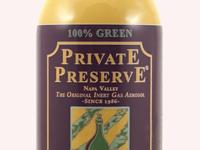Storing whisky - experiments with inert gas, small bottles and oxidisation
Contents

I’m going to preface this by saying that whisky is not intended to be stored for long once opened, and even in the face of extreme measures your open bottle is going to change overtime. It’s also worth understanding that while I did this blend and tried to be as scientific as possible it is simply not possible to account for every variable. The tips and recommendations here are about slowing down the rate of change to allow you longer to enjoy your favourite dram, not creating some sort of whisky time capsule.
Popular methods for protecting whisky against oxidisation
- Decanting to smaller bottles
- Inert gas spray (Argon, Nitrogen etc.)
- Vacuum inducing devices
- Wax or Parafilm
- Filling the bottle with food grade marbles
In my opinion the last method is completely impractical and not worth considering within the confines of this experiment*. I would also note that although Parafilm is moisture resistant it has gas permeability. This means it’s great for transporting your bottles but not so great for storage. For this reason I opted for the use of wax seals, though it would be interesting to compare the two.
*I suspect this method would achieve similar results to leaving the bottle mostly full or using sample bottles without seals
Findings
The outcome of my comparison is unlikely to surprise anyone but interesting nonetheless. In order best to last:
- Small bottles sealed with wax
- Small bottles
- Inert gas
- Vacuum inducing device
Using a similarity score, 5 = identical, 1 = this is another whisky this trend bore out over the course of a year:
Laphroaig
| Time Period | Bottle with wax | Bottle without wax | Inert Gas | Vacuum |
|---|---|---|---|---|
| 3 months | 5 | 5 | 5 | 4 |
| 6 months | 5 | 5 | 4 | 3 |
| 9 months | 5 | 5 | 3 | 1 |
| 12 months | 5 | 4 | 3 | 1 |
After a year of sitting in the cupboard the small bottles sealed with wax were unchanged so far as I could discern. The small bottles without wax had held up spectacularly well as well. While I did note some change in the bottles without wax these were extremely small and this may reflect a problem with my scoring system (see musings).
The oxidisation experiment
I’ve written before about the various methods for storing whisky, and about the use of inert gas for whisky storage before so I’ll forgo the why and focus instead on the what. I’ve conducted a small series of tests previously but wanted to do something a little more rigourous. I opted for Private Preserve over Preservintage Wine Preserver as the former came out on top in a previous experiment (though there was very little discernible difference between the two).
Shopping list
- 6 * bottles of Laphroaig 10
- 6 * bottles of Glen Elgin 10
- 8 * 50cl bottles
- 8 * 5cl bottles
-
- Sealing wax (food grade)
-
- Intert gas (Private Preserve)
- labels + pen
What I did (so you can pick it apart)
I purchased several bottles of two whiskies I know very well, opened 2 bottle of each. After satisfying myself that there was no discernible difference in nose/palate these were decanted using a range of the storage methods listed above and compared these (blind) to the newly opened bottles* over the course of a year. The newly opened bottles were decanted accordingly:
4 * 10cl into 50cl bottles (Inert Gas) 4 * 10cl into 50cl bottles (Vacuum) 4 * 5cl into 5cl bottles (no wax seal) 4 * 5cl into 5cl bottles (wax seal)
The bottles were opened, poured into clean glencairns and then nosed and tasted alongside glasses from the newly opened bottle, samples from a previously opened bottle (in all cases but the first instance the bottle was the one opened 3 months ago and missing only a few drams). I would then sit with two glasses and score them as being similar/not. For reference I’m also including my new versus old scoring:
| Time Period | New bottle versus old |
|---|---|
| 3 months | 3 |
| 6 months | 5 |
| 9 months | 4 |
| 12 months | 5 |
| As you can see the first bottle I |
*sourced at the same time
Experimental considerations
An unopened bottle of whiskey has two primary enemies – temperature and light. A combination of bright lights and frequent temperature fluctuations can act as catalysts for a chemical reaction in the whiskey. When exposed to catalysts, all the compounds that make your whiskey taste so unique will eventually begin to break down. This can turn a fine whiskey, distilled and then left to mature for years, into a bitter and unpleasant beverage.
Musings
Ultimately I don’t think I was ever going to be truly happy with the experiment though I am confident I did the best I could have hoped. My biggest niggle is the possible discrepancies between bottles, though I did my best to try and source bottles from the same batch and the wax result does seem to bear that out. I also wasn’t as happy with my scoring system by the end. I’m not certain I could discern changes on anything larger than a 5 point scale, though the change in the small bottles after a year was negligible - losing a whole point for what was virtually no difference seems wrong somehow.
I think my next crack at this will be using a single bottle and wax seals as the standard. The main issue with this is that I won’t have answers for a year or two.
Previous

